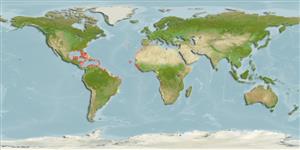Actinopterygii (ray-finned fishes) >
Perciformes (Perch-likes) >
Kyphosidae (Sea chubs) > Kyphosinae
Etymology: Kyphosus: Greek, kyphos = bent (Ref. 45335).
Environment / Climate / Range
Ecology
Marine; reef-associated; depth range 1 - 15 m (Ref. 95687). Subtropical, preferred ?; 42°N - 34°S, 98°W - 23°E
Western Atlantic: Cape Cod, Massachusetts (USA) to Brazil. Also found in Argentina (Ref. 86336). Eastern Atlantic: Madeira Island (Ref. 74541), São Tiago Island (Cape Verde) and Angola (Ref. 7373); Sao Tome Island (Ref. 30488).
Size / Weight / Age
Maturity: Lm ? range ? - ? cm
Max length : 90.0 cm SL male/unsexed; (Ref. 6547); common length : 45.0 cm TL male/unsexed; (Ref. 3725); max. published weight: 3.9 kg (Ref. 40637)
Dorsal
spines
(total): 11;
Dorsal
soft rays
(total): 13-15;
Anal
spines: 3;
Anal
soft rays: 12 - 13. grey with longitudinal brassy stripes on body and 2 brassy horizontal bands on head. Opercular membrane slightly pigmented. Each jaw with a regular row of close-set, strong, incisor-like, round-tipped teeth of a peculiar hockey-stick shape, their bases set horizontally, resembling a radially striated bony plate inside mouth (Ref 52729).
Inhabits shallow waters, especially over rocky bottoms in coral reef areas; also among floating Sargassum weeds (Ref. 3725). Feeds on algae including much Sargassum (Ref. 5521). Marketed fresh (Ref. 3725).
Life cycle and mating behavior
Maturity | Reproduction | Spawning | Eggs | Fecundity | Larvae
Robins, C.R. and G.C. Ray, 1986. A field guide to Atlantic coast fishes of North America. Houghton Mifflin Company, Boston, U.S.A. 354 p. (Ref. 7251)
IUCN Red List Status (Ref. 115185)
CITES (Ref. 94142)
Not Evaluated
Threat to humans
Harmless
Human uses
Fisheries: minor commercial; gamefish: yes
More information
ReferencesAquacultureAquaculture profileStrainsGeneticsAllele frequenciesHeritabilityDiseasesProcessingMass conversion
Tools
Special reports
Download XML
Internet sources
